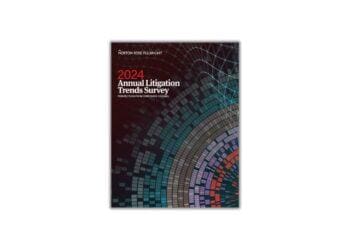Litigation can bring any company’s legal and compliance functions grinding to a halt. The answer is to bring in external counsel. Still, impasses can crop up, and legal can be tapped strategically (such as during discovery). ‘Fixer’ and experienced litigator Kelly Purcaro offers the following tips to streamline this challenging process.
The last thing any executive or business leader wants to do is waste time on litigation, and when disputes arise most companies want to resolve them quickly. Often companies will retain outside counsel to handle litigation to ensure in-house GCs, legal, executives and compliance focus on their core work of running a business.
Unfortunately, sometimes litigation becomes intractable. When that happens, here are four critical elements that can help companies work with their outside counsel to get their litigation back on track.
- Review goals and clearly define what a successful resolution looks like for the company.
- Establish clear, cooperative communication and look for common ground.
- Assess resources and streamline responsibilities from a cost and business perspective.
- Recapture case momentum, define your own battlefield and create leverage for tactical advantage at litigation milestones.
Cases are like snowflakes — no two are alike. Be sure the litigation is viewed from a business perspective and consider the amount in controversy, the procedural posture, the party dynamics and the case history. To design the correct approach, counsel must understand the litigation landscape, the nuances of the relationship dynamics within the case and within the company, and the obstacles that have prevented the case from progressing. The company receives the most benefit when its litigation counsel considers the company’s business needs and collaborates in developing litigation strategy designed to achieve the company’s business objectives.
1) Eyes on the Prize: Define the Goals
Complex multiparty commercial litigation often involves very smart attorneys, but they can become so busy litigating that they lose focus on what truly matters to the client. Attorneys have been trained to win in the courtroom, but a cookie cutter approach, like full throttle litigation, is not always in the company’s best interests.
The first step in repairing the litigation strategy and getting a case back on track involves reopening lines of communication and getting clear on what success means for the company. What does winning look like? How much will it cost to fight all the way to a jury trial? Could a settlement be more cost effective? Could a settlement harm the business or its reputation in the industry? With the goals clearly defined, it’s time to make clear communication a major priority, both with the client and legal team and with the opposition.
2) Communicate Effectively and Identify Common Ground
After the company’s goals have been clearly defined, make sure to stay on track. Set up a system for reporting, including anticipated budgets and case timelines. Make sure attorneys clearly explain anticipated expenses or major tactical moves and ensure that there is a regular flow of information between outside counsel and the in-house team. The client should be regularly informed of progress towards the goals, how developments in the case impact the overall strategy, and what potential adjustments may be necessary to stay the course. There are no guarantees in litigation and, particularly in complex civil cases, it can be difficult to predict how the case may evolve. The job of counsel to a company is to do just that: counsel and advise so that the client is empowered with the information necessary to make the best decisions for its business. Once the communication is flowing, it’s time to repair the relationship with opposing counsel.
Litigation is stressful and may unfortunately devolve into unnecessary hostility among counsel. Animosity can lead to stalemate and can result in unnecessary delays as well as avoidable costs. Remember that everyone involved in litigation is human, and not every battle is worth fighting. Not only is cordial communication vital to the relationship with outside counsel to ensure that litigation gets resolved expediently, but it’s also often vital between adversaries. Indeed, civility within the legal profession is possibly one of the most important aspects of the profession.
Finding middle ground with the opposition, when to do so would not result in prejudice to the client’s position, can help both in keeping the litigation on track and reducing unnecessary costs for everyone. For example, rather than bogging down the court with motions for every procedure, attorneys on both sides can (and are often required to) work out stipulations where they are agreeable, helping things move forward quickly. This reduces the burden on the courts as well as the clients.
Candor, competence, and following through in a professional and timely manner will reflect your integrity. Find agreements in the procedural elements of litigation and common ground in professional and ethical obligations that bind the attorneys on both sides of the “v.” These negotiations and commonalities could serve as rehearsals for settlement talks down the road.
3) Assess and Deploy Resources
Discovery is where most cases are won, but it’s also where they often get stuck. Companies have businesses to run and key executives often cannot dedicate scarce resources to litigation. Foot-dragging and confusion about who is responsible for producing discovery, who can retrieve the requisite information, and who are the primary custodians of relevant discovery information may cause delays and weaken the case.
With the company’s goals and its unique structure in mind, map out responsibilities for handling discovery demands. Is there an IT system for retrieval of electronically stored information (ESI) from the primary custodians? Does a staged term search discovery production make the most sense for the company in terms of internal resources? How well does the company’s point person(s) during the discovery process interact with outside counsel? Make sure everyone is clear about what needs to be done and who needs to do it, and make sure it gets done. When you are delegating responsibilities, notice any weaknesses in the company’s procedures that can be corrected to avoid unnecessary costs and delays in the future.
Issue-spot company processes for improvements, starting with implementing protocols to preserve evidence. The goals are to be able to know when an obligation to preserve evidence is triggered and, when the time comes for production, to quickly identify documents needed for compliance and litigation. That way, next time litigation comes up, the custodians or IT personnel can quickly obtain the information and attorneys can quickly process and produce discovery without having to overly burden leadership with cumbersome searches, tracking down emails, and searching for documents.
As you reorganize the litigation strategy and clarify internal processes, assess your resources, and see where you can save time and money. For instance, a company may have a compliance team, paralegals, human resources, IT and administrative support available to assist in discovery collection rather than relying solely upon an outside counsel’s team that bills by the hour. Make sure your outside legal team is using resources wisely.
4) Shift the Momentum and Create Leverage
Sometimes the best outcome for a company will be a trial on the merits of the case. Other times a settlement may make better business sense. Litigation counsel should be mindful that anything is possible and that finding a good place to offer a resolution, should the company choose to do so, will require leverage. Part of that leverage involves shifting the momentum of the case.
Map out the litigation status so that you have a full picture of where the case stands as you plan how best to move forward. This includes understanding the procedural posture of the case, a clear understanding of the upcoming deadlines, and a full grasp of the status and volume of discovery exchange and pending. Has the client responded to all demands pending? Are there any depositions pending or that should be pending? What are the judicial preferences of the judge and how do the local rules impact scheduling matters?
Make sure there are no motions pending against you. Are there or should there be any motions filed against your adversary? Has your adversary complied with all discovery obligations or are there deficiencies you should raise with opposing counsel? Are there any other discovery gaps and if so, how can you get what you need for your case? For example, if the scheduling order or applicable rules limit the number of demands you can make or depositions you can take, you will have to carefully review what has been exhausted and how to strategically move forward. Importantly, you will also want to make sure your adversary has not exceeded any limits on discovery demands because the other side is not typically entitled to do so without leave of court. Getting your side of the street cleaned up and shifting the discovery burden onto your adversary allows you to define the field of battle, exert pressure on the other side, and regain litigation control.
Once you have a good understanding of the case status and have reframed the landscape, the company can then strategize with litigation counsel on options and leverage opportunities moving forward. Counsel and client should have a clear understanding of which stages of the case present the most exposure both in terms of position and increased legal expenses. For example, depositions are often expensive. Exploring resolution options prior to incurring deposition costs may be in the best interest of your company.
Another major expense is often expert discovery, which typically occurs shortly after fact discovery ends. This is another stage in the litigation in which parties are more likely to revisit their litigation position, reexamine the strategy, and decide how best to move forward based on how the case has evolved. Judges will often schedule a status conference around this time to see if the parties may be interested in exploring settlement because, as the case and the costs proceed, the likelihood of a pre-trial resolution becomes more elusive.
Companies guided by experienced litigators who can identify these natural stages of opportunity in the case, create leverage throughout the litigation, and collaborate on best strategies for the company’s goals will be best positioned for success. Many companies may want to walk away from litigation without spending too much money. Other companies may be willing to spend whatever it takes to protect their image in the market. An outside litigation counsel with your company’s interests top of mind should be looking for the right place to find the most cost-effective strategy for your particular business objective.
Integrating Lessons Learned
Of course, companies should strive to prevent lawsuits in the first place. By developing and enhancing compliance procedures and preventative measures, companies can often avoid expensive litigation. When facing a war, you should always define your own battlefield. In business and in litigation, your ammunition is best practices and planning. Staying ahead of the ever-changing landscape of compliance issues will serve your company well for any future disputes that may arise.
If and when litigation does arise, and it is not progressing in a way that suits the company, the in-house legal team (whether GCs or C-suite executives) and litigation counsel should work together to: (1) define and focus on achieving the company’s business objectives, (2) establish effective communication; (3) assess and wisely deploy internal resources; and (4) look for leverage opportunities to help shift the case momentum in the company’s favor.



 Kelly M. Purcaro is a partner at A.Y. Strauss and co-chair of the Litigation Group specializing in complex civil and commercial litigation across the United States. Purcaro also serves as chair of the Class Action Practice Group. An experienced trial lawyer and former lobbyist, for more than two decades Purcaro has worked closely with companies and legislators, and has litigated a wide array of matters in federal and state courts, developing a reputation for recapturing momentum in stalled litigation and achieving outcomes that are in the best interest of the client. She serves as co-chair of the New Jersey State Bar Association Class Action Committee, is featured on the Amazon Prime Docuseries “LuLaRich,” and has lectured as a guest speaker at state and federal legal education conferences throughout country.
Kelly M. Purcaro is a partner at A.Y. Strauss and co-chair of the Litigation Group specializing in complex civil and commercial litigation across the United States. Purcaro also serves as chair of the Class Action Practice Group. An experienced trial lawyer and former lobbyist, for more than two decades Purcaro has worked closely with companies and legislators, and has litigated a wide array of matters in federal and state courts, developing a reputation for recapturing momentum in stalled litigation and achieving outcomes that are in the best interest of the client. She serves as co-chair of the New Jersey State Bar Association Class Action Committee, is featured on the Amazon Prime Docuseries “LuLaRich,” and has lectured as a guest speaker at state and federal legal education conferences throughout country.






